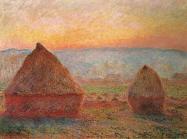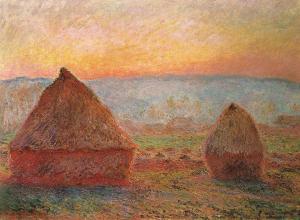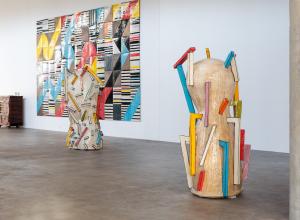FROM CONVENTIONAL TO ADVENTUROUS
Roederstein, who signed her works with the initials OWR, worked specifically for the art market, in order to make her living as a freelance artist. She adhered to the conventions that female artists were expected to abide by. Early in her career, that meant employing a dark-toned palette of colours and choosing portraits and still lifes as her subjects. Yet she soon found herself venturing beyond the allotted domain of women painters, producing religious images and nudes. Around 1893, encouraged by her study of works from the Italian and German Renaissance, she began painting in tempera. This technique, which underwent a revival across Europe in the closing years of the 19th century, was regarded as at once traditional and avant-garde. In her more mature work, Roederstein exhibited a growing openness to other trends, incorporating both Impressionist and Symbolist elements into her art. Then, in the 1920s, she adopted her signature, objective and sober visual language. Her many self-portraits played a large role in her work. Designed by curator Sandra Gianfreda to include a representative selection of paintings and drawings, the exhibition visits the principal locations of Roederstein’s career–Zurich, Berlin, Paris, Frankfurt am Main and Hofheim am Taunus–in chronological order, and is enhanced by previously unpublished photographic and archive material. It also includes around a dozen paintings held by the Kunsthaus itself, which began collecting Roederstein’s works in the 1890s and showed them in fifteen solo and group exhibitions up until 1934.

Ottilie W. Roederstein, Quinces, 1929. Tempera on canvas. Kunstmuseum Bern, gift of the artist.
She was one of the leading female painters of her generation and the most important Swiss female portrait artist of the early modern era. Her name: Ottilie W. Roederstein. A new retrospective at the Kunsthaus Zürich honors an artist who was often the only woman representing Switzerland abroad, alongside her contemporaries Hodler, Amiet and Giacometti.
During her lifetime, Ottilie Wilhelmine Roederstein (1859–1937) was the most important female Swiss portrait painter. Her portraits and still lifes were widely admired not only in her homeland but also in Germany and France, and from 1883 onwards she successfully exhibited her work in Paris, London, Frankfurt am Main and Chicago. In 1912 she was the only female artist representing Switzerland at the seminal ‘International Art Exhibition of the Sonderbund’ in Cologne–alongside male colleagues including Ferdinand Hodler, Giovanni Giacometti and Cuno Amiet. Yet despite her considerable international renown, Roederstein lapsed into obscurity almost immediately after her death. More than 80 years on, the exhibition of some 75 works at the Kunsthaus Zürich is the first monographic presentation in Switzerland to place this artist’s stylistically diverse oeuvre once again before a wider audience.

Ottilie W. Roederstein, Irene Holz, née Edle von Hofmann,
1919. Tempera on canvas. Private collection, Zurich.

Ottilie W. Roederstein, Boy with Cherries, 1899. Oil on canvas. Private collection, Frankfurt am Main.
AN IMPORTANT PORTRAIT PAINTER FOR GERMANY AND SWITZERLAND
Ottilie W. Roederstein was an artist with close ties to the Kunsthaus Zürich. Born in Zurich to German parents, she lived and trained in her home city as well as Berlin and Paris before moving in 1891 to Frankfurt am Main. In 1909 she and her partner Dr. Elisabeth H. Winterhalter, a gynecologist and Germany’s first female surgeon, settled in rural Hofheim am Taunus. Roederstein and Winterhalter supported each other, venturing into disciplines that were traditionally male preserves and making careers for themselves in art and medicine respectively. Roederstein became an established name in the German and Swiss cultural scene. Much in demand as a portrait artist herself, she promoted other artists by purchasing their works for her own collection, supported exhibitions of modern French and Swiss art, and encouraged their wider dissemination in Germany and Switzerland. In 1920, she donated works from her collection of modern French and Swiss art to the Kunsthaus, laying the foundations for a department of contemporary art from France.
FIRST SWISS RETROSPECTIVE FOR MORE THAN 80 YEARS
Commemorative exhibitions of Roederstein’s work were staged in 1938 in Frankfurt, Zurich and Bern in recognition of her artistic legacy and tireless work as a mediator between Switzerland and Germany; but the rift opened up by the Second World War and the art world’s general focus on abstract painting caused Roederstein’s work to be forgotten. Now, her multifaceted oeuvre is waiting to be rediscovered in an overview exhibition in Switzerland. The retrospective at the Kunsthaus Zürich pays tribute to Roederstein’s remarkable career and locates her in the context of her time. It also coincides with the recent re-cataloguing of her estate. Among its documented findings is that Ottilie W. Roederstein was active not just as a painter but also as a promoter of women’s education, and was also a leading figure in an extensive network of free-spirited artists and intellectuals.
























